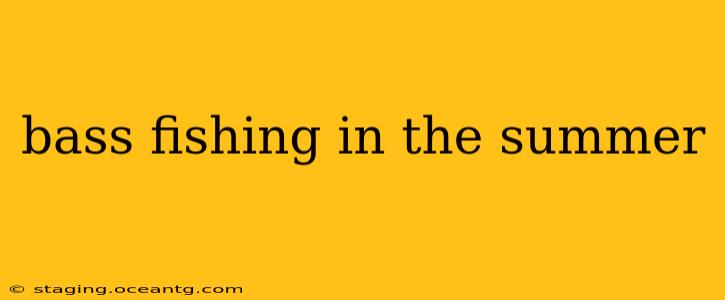Summertime fishing for bass presents unique challenges and rewards. The scorching sun, changing water temperatures, and shifting bass behavior require anglers to adapt their strategies. This comprehensive guide will equip you with the knowledge and techniques to successfully target bass during the hottest months of the year. We'll explore the best locations, lures, and techniques to maximize your chances of a successful summer fishing trip.
What are the best lures for bass fishing in the summer?
Summer bass often become more lethargic due to the heat, requiring anglers to use slower-moving or more subtle lures. Top choices include:
- Texas-rigged worms: The classic Texas rig allows the worm to fall naturally, mimicking a wounded baitfish. Experiment with different colors and weights to match the water clarity and depth.
- Creature baits: These soft plastic lures, often resembling crawfish or other aquatic creatures, are excellent for triggering strikes from inactive bass.
- Spinnerbaits: While generally faster-moving lures, spinnerbaits can be effective in the summer when fished slowly along cover. The flash and vibration can attract bass from a distance.
- Jigs: Jigs are versatile and can be fished slowly along the bottom, targeting bass holding near structure.
- Topwater lures: While not always effective during the hottest parts of the day, topwater lures can be deadly during low-light hours or overcast conditions, provoking aggressive strikes from hungry bass.
Where are the best places to fish for bass in the summer?
Bass will seek out areas that offer shade, cooler water temperatures, and ample cover. Summer hotspots often include:
- Deep water structures: Docks, submerged trees, and other deep-water structures offer refuge from the sun and attract baitfish, drawing bass to these areas.
- Shady areas: Look for areas with overhanging trees, lily pads, or other vegetation that provide shade and cooler water.
- Points and shorelines: Points and shorelines are often prime feeding areas for bass, as baitfish congregate near the edges of drop-offs.
- Weed beds: While bass might not be as aggressive in thick weed beds during the summer's heat, carefully navigating these areas can be incredibly productive.
What is the best time of day to fish for bass in the summer?
Summer bass often become most active during the cooler hours of the day:
- Early morning: As the sun rises, bass become more active, feeding before the water temperature increases significantly.
- Late evening: As the sun sets, the water temperature cools down, and bass once again become more active.
- Overcast days: On cloudy or overcast days, bass may be more active throughout the day as the water remains cooler.
How do I find bass in the summer?
Locating bass in the summer requires a keen understanding of their behavior. Here are some effective techniques:
- Use your electronics: A fish finder can be invaluable in locating submerged structure and locating schools of baitfish, indicating the presence of bass.
- Observe your surroundings: Look for signs of bass activity, such as surface disturbances, jumping fish, or birds diving.
- Experiment with different locations: If you're not having success in one area, try moving to another location that offers different types of cover and depth.
What techniques are most effective for summer bass fishing?
Success in summer bass fishing often hinges on employing the right techniques:
- Slow and steady retrieve: A slow, deliberate retrieve is often more effective than a fast, erratic retrieve, particularly when the water is warm.
- Target specific structure: Concentrate your efforts on areas with ample cover and shade, where bass are most likely to be holding.
- Use scent attractants: Adding scent attractants to your lures can increase their effectiveness, especially when bass are less active.
What size hooks should I use for summer bass fishing?
The hook size depends on the lure and the size of bass you expect to encounter, but generally, a size 1/0 to 4/0 hook is appropriate for most summer bass fishing situations. A stronger hook is also advisable for those powerful summer bass.
What type of line should I use for summer bass fishing?
Braided line offers excellent sensitivity and strength, enabling you to feel subtle bites and set the hook effectively. Fluorocarbon line is another good option due to its low visibility.
This guide provides a solid foundation for tackling summer bass fishing. Remember to always check local fishing regulations and practice responsible angling. Tight lines and happy fishing!
